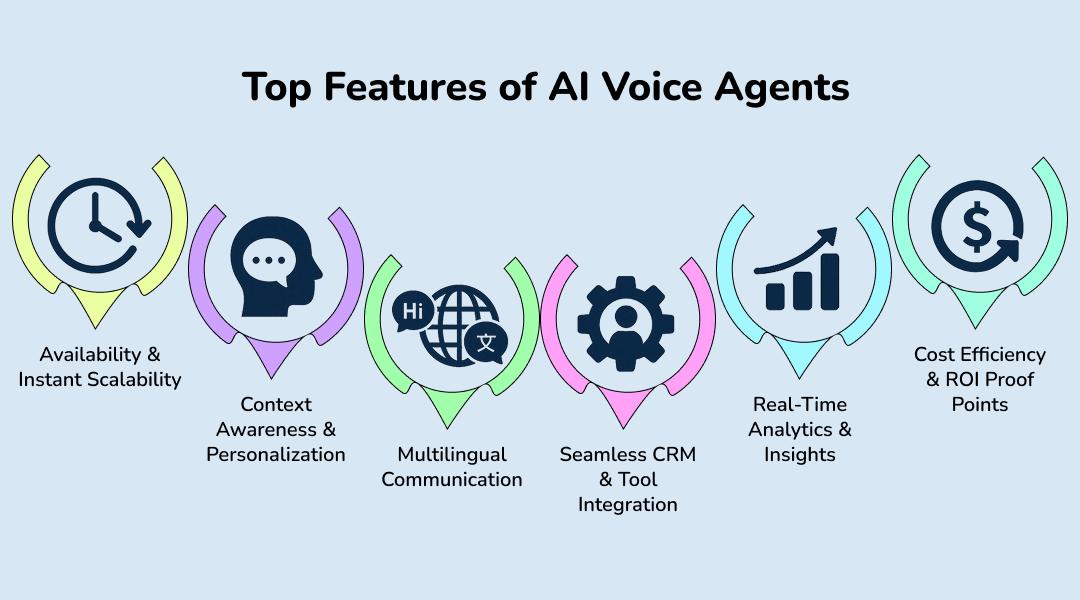7 Amazing Features of AI Voice Agents You Should Know
Let’s be honest. You’re probably reading this because you’ve heard AI voice agents can “transform” customer service. But you’ve also heard that before about a dozen other technologies. So why should you trust this one?
Because I’ve seen it work—again and again.
I’m not talking about flashy demos. I mean real-world deployments: a mid-sized e-commerce company in Delhi that slashed their average call wait time by 65%. A healthcare chain that reduced missed appointments by 40% thanks to automated reminders. A fintech startup that went from struggling with support tickets to handling triple the volume without hiring a single extra agent.
And the magic isn’t magic. It’s features. Very specific ones. Today, I’ll walk you through the 7 amazing features of AI voice agents you should actually care about.
Top Features of AI Voice Agents

Natural Language Understanding (NLU)
The best AI voice agents don’t just hear words—they understand intent. That’s the difference between a clunky IVR menu and a conversational AI voice agent that feels almost human.
Ask, “I need to change my delivery address,” and it shouldn’t confuse that with “track my delivery.” That’s NLU at work.
Why does it matters? Because frustrated customers hang up. And every hang-up costs you money, brand trust, and sometimes lifelong loyalty.
Availability & Instant Scalability
Your customers don’t care about office hours. They care about answers—fast.
AI voice assistants for business don’t take breaks, don’t get sick, and don’t quit because they’re bored answering the same question 50 times. They scale up instantly when call volumes spike (say, during a holiday sale or product recall) and scale down when things are quiet.
And no—this doesn’t mean replacing humans entirely. It means your human team finally handles the complex calls while AI voice bots take the repetitive ones off their plate.
Context Awareness & Personalization
Here’s a nightmare: calling customer support, explaining your problem, getting transferred… and having to repeat everything again.
AI voice agents in customer service solve this with context awareness. They remember conversations, pull data from CRMs, and personalize interactions. Instead of “How can I help you?” every time, it’s: “Hi John, I see you ordered a laptop last week. Are you calling about that order?”
That’s not just efficient—it’s respect for your customer’s time.
Multilingual Communication
Business is global. Your customers might not all speak English.
Virtual AI call assistants can handle multiple languages out of the box—Hindi, Spanish, Arabic, you name it. This isn’t just “translation”; good systems adapt tone, phrasing, and even regional variations.
The benefit? No missed sales or frustrated customers just because of a language gap.
Seamless CRM & Tool Integration
Here’s the thing: AI voice agents don’t live in a vacuum. They shine when integrated into your existing systems.
That means plugging directly into CRMs like Salesforce, helpdesk tools like Zendesk, or even your in-house ERP. Voice AI automation makes data flow automatically—no more agents manually copy-pasting call notes into customer profiles.
This is where businesses see productivity skyrocket.
Real-Time Analytics & Insights
Here’s something many executives overlook: AI call assistant features don’t stop at customer-facing tasks.
They also generate data gold. Real-time dashboards showing call volumes, common customer complaints, sentiment analysis, and resolution rates.
That’s intelligence you can act on: improving your product, re-training your staff, or spotting an issue before it blows up on Twitter.
Cost Efficiency & ROI Proof Points
Let’s talk money.
The benefits of AI voice agents aren’t theoretical. I’ve watched companies cut customer service costs by 30–50% within months of deployment. Why? Because automation reduces staffing strain, lowers turnover, and speeds up resolution times.
That’s not “future value.” That’s measurable ROI.
Future of AI Voice Automation
Where is this going? Toward smarter, more human-like interactions.
Think conversational AI voice agents that can detect emotions, adjust tone, and even escalate seamlessly to a human when empathy is required. Think AI-powered customer support solutions that work across voice, chat, and video in one unified system.
This isn’t 2050. It’s already happening.
Common Misconceptions & Challenges
Let me cut through the myths:
“AI will replace humans.” False. It will redefine their roles.
“AI voice bots sound robotic.” Old ones did. The best AI voice assistant tools today sound shockingly natural.
“It’s too expensive.” Not if you weigh it against the cost of high churn, long queues, and burnt-out staff.
Yes, there are challenges, data privacy, integration hurdles, cultural adoption. But those are solvable with the right partner. (This is where a company like KriraAI comes in.)
How to Choose the Best AI Voice Assistant Tools
Three things to check before signing any contract:
Flexibility – Does it integrate with your tech stack?
Accuracy – How well does its NLU handle accents, slang, and domain-specific terms?
Support – Is there a reliable AI voice agents company behind it, offering ongoing updates and training?
Don’t get dazzled by sales pitches. Ask for a proof of concept. Measure real metrics.
Conclusion
AI voice agents aren’t “nice to have” anymore—they’re a competitive necessity.
But the point isn’t adopting them because everyone else is. It’s adopting them because they work. They save time. They cut costs. They improve customer satisfaction.
And in a business climate where efficiency and loyalty are everything, that’s not optional. That’s survival.
If you’re ready to explore the best AI voice agent solutions, or even want to discuss whether you should hire an AI developer for a more custom approach, KriraAI is here to help.
FAQs
Healthcare, e-commerce, finance, SaaS, and logistics companies see the fastest ROI due to high call volumes.
Not better, different. They handle repetitive calls well, leaving humans for empathy-driven, complex cases.
Enterprise-grade AI voice assistants follow strict data governance and compliance standards like GDPR and HIPAA.
Yes. Most businesses cut service costs by 30–50% within months due to reduced staffing strain and faster resolution times.
Chatbots work in text-based channels. Voice agents handle real-time, spoken conversations, often integrated with chat systems for a complete solution.

CEO
